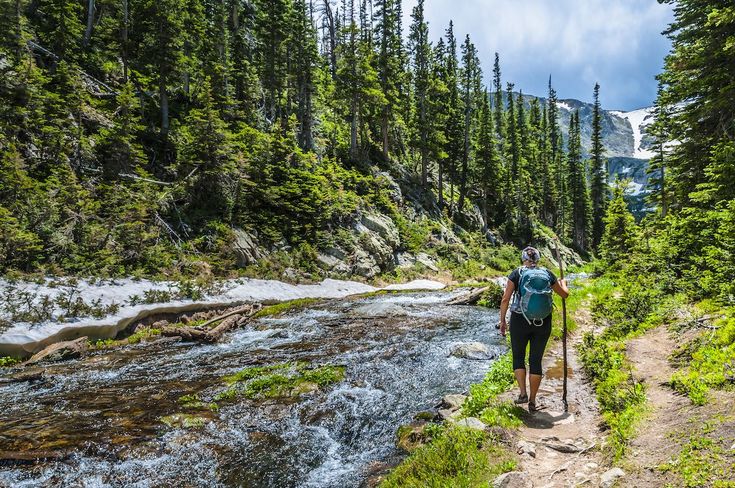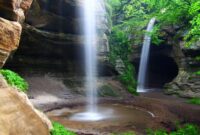Hiking camping trails near me: Discover the thrill of exploring nature’s beauty right on your doorstep. This guide delves into finding, planning, and enjoying local hiking and camping adventures, catering to various experience levels and preferences. Whether you’re a seasoned adventurer or a weekend warrior, we’ll equip you with the resources and information needed for a safe and memorable experience.
From identifying your ideal trail based on difficulty and proximity to understanding essential camping considerations and safety protocols, this comprehensive resource will help you make the most of your outdoor exploration. We’ll cover everything from choosing the right gear to navigating using online tools and appreciating the stunning landscapes along the way.
Understanding User Search Intent
The search query “hiking camping trails near me” reveals a user’s immediate need for recreational outdoor activities within their geographical proximity. Understanding the nuances behind this seemingly simple query requires examining the diverse motivations and expectations of potential users. The intent is not just about finding trails; it’s about finding trails that fit specific needs and preferences.
The motivations behind searching for “hiking camping trails near me” are multifaceted. Some users might be seeking a weekend getaway, prioritizing convenience and accessibility. Others may be planning a longer backpacking trip, requiring more detailed information on trail difficulty, water sources, and campsite availability. The query can also stem from a desire for a solitary experience, a group adventure, or a family outing. The level of experience and preparedness also varies widely.
User Motivations and Trip Types
Users searching for local hiking and camping trails represent a broad spectrum of outdoor enthusiasts. For example, novice hikers might be looking for easily accessible, well-maintained trails with minimal elevation gain, suitable for a short day hike. Experienced backpackers, conversely, might seek challenging trails with rugged terrain and remote campsites, requiring significant planning and preparation. Families with young children will prioritize safety, shorter distances, and kid-friendly amenities. Solo hikers might emphasize solitude and the opportunity for self-reflection, while groups might focus on shared experiences and social interaction. Furthermore, some searches might originate from individuals looking for specific activities along the trails, such as birdwatching, photography, or rock climbing.
User Needs and Expectations
Users performing this search typically have specific needs and expectations. These include accurate information on trail length, elevation gain, difficulty level, and overall trail conditions. Access to detailed maps, ideally with GPS coordinates, is crucial. Information on campsite availability, water sources, and restroom facilities is also highly sought after. Reviews and ratings from other users can greatly influence the decision-making process, providing insights into trail safety, scenic views, and overall experience. Accessibility information, considering factors like trail surface and incline, is particularly important for users with mobility limitations. Finally, many users will also be looking for information on parking availability, permit requirements, and any potential hazards or safety concerns.
Locating Relevant Trails
Finding the perfect hiking and camping trails near you involves leveraging various resources and employing effective search strategies. This section outlines key resources, filtering techniques, and a step-by-step guide to using online mapping tools for efficient trail discovery.
Resources for Finding Local Trails
Several excellent resources can help you locate hiking and camping trails. Choosing the right resource depends on your specific needs and preferences. The table below provides a comparison of popular options.
| Resource Name | Website URL | Description | Reliability |
|---|---|---|---|
| AllTrails | www.alltrails.com | A comprehensive database of trails with user reviews, photos, and detailed trail information. Offers various filtering options. | High |
| Hiking Project | www.hikingproject.com | Another popular trail database with similar features to AllTrails, including user-submitted data and detailed trail maps. | High |
| Recreation.gov | www.recreation.gov | Focuses on trails and campsites managed by the US federal government. Useful for finding trails in national parks and forests. | High |
| Local Parks and Recreation Departments | (Vary by location) | Check your local government websites for information on trails and parks within your community. | High (for local trails) |
Filtering Trail Search Results
Effective filtering is crucial for narrowing down your search to trails that match your preferences and capabilities. Most online trail databases allow you to filter results based on several key criteria. For example, you can filter by difficulty level (easy, moderate, strenuous), trail length (in miles or kilometers), elevation gain (in feet or meters), and proximity to your current location or a specific address. Using these filters ensures you find trails suitable for your fitness level and experience.
Using Online Mapping Tools to Discover Trails
Online mapping tools are invaluable for discovering and planning hikes. Here’s a step-by-step guide:
- Choose a Mapping Tool: Select a mapping tool like Google Maps, AllTrails, or Hiking Project. These platforms offer detailed trail maps, elevation profiles, and often user reviews.
- Set Your Location: Enter your current location or the area you want to explore. Many tools allow you to specify a radius around a point to focus your search.
- Apply Filters: Use the available filters to refine your search. Specify desired difficulty, length, elevation gain, and other preferences.
- Review Trail Information: Carefully examine the trail details, including elevation profiles, user reviews, and photos. This helps you assess the trail’s suitability and potential challenges.
- Plan Your Route: Once you’ve selected a trail, use the mapping tool to plan your route. Consider parking locations, trailheads, and potential points of interest along the way.
- Download Offline Maps (Optional): For areas with limited or no cell service, download offline maps of your chosen trail for navigation.
Trail Information and Descriptions
Providing comprehensive and accurate trail information is crucial for ensuring hiker safety and enjoyment. Clear descriptions allow users to make informed decisions about which trails best suit their abilities and experience levels. This includes not only the physical aspects of the trail but also potential hazards and necessary precautions.
Providing detailed trail descriptions helps hikers prepare adequately for their journey, reducing the risk of accidents and enhancing their overall experience. This section details the essential information that should be included in any trail description.
Essential Trail Information
The following elements are vital for a complete trail description. A well-structured description will enhance a hiker’s preparedness and enjoyment of the trail.
- Trailhead Location: Precise directions to the trailhead, including GPS coordinates, are essential. For example, “The trailhead is located at the end of Willow Creek Road, approximately 0.5 miles past the intersection with Highway 12. GPS coordinates: 34.56789° N, 118.12345° W.” This ensures hikers can easily find the starting point.
- Distance: The total length of the trail, clearly stated in miles or kilometers. For instance, “Trail length: 5.2 miles (8.4 km).” This allows hikers to estimate the time commitment required.
- Elevation Profile: A description of the elevation changes along the trail, including total elevation gain and loss. For example: “The trail features a steady climb of 1,500 feet (457 meters) over the first 2 miles, followed by a relatively flat section before a final descent of 800 feet (244 meters).” This helps hikers understand the physical demands of the trail.
- Difficulty Level: A clear indication of the trail’s difficulty, using a standardized scale (e.g., easy, moderate, strenuous). This should consider factors such as terrain, elevation gain, and trail maintenance. For example, “Difficulty: Strenuous – This trail involves significant elevation changes and potentially challenging terrain.” This allows hikers to self-assess their fitness level.
Safety Information in Trail Descriptions
Including safety information is paramount to minimizing risks and ensuring hiker well-being. Failing to adequately address potential hazards can have serious consequences.
- Potential Hazards: Clearly identify any potential hazards along the trail, such as steep drop-offs, exposed sections, water crossings, wildlife encounters (e.g., bears, snakes), or areas prone to rockfalls. For example, “Caution: Steep cliffs present a significant fall hazard. Be mindful of your footing and avoid the edge.” This allows hikers to anticipate and mitigate potential risks.
- Emergency Contacts: Provide relevant emergency contact information, including local park rangers, search and rescue teams, and emergency services numbers. For example: “In case of emergency, contact Park Rangers at 555-1212 or dial 911.” This provides immediate access to help in case of an accident or emergency.
- Recommended Gear: Suggest appropriate gear and clothing for the trail based on its conditions and potential hazards. For example, “Recommended gear: Sturdy hiking boots, layers of clothing, plenty of water, sunscreen, and a first-aid kit.” This helps hikers prepare for all possible conditions.
- Weather Conditions: Provide information on typical weather conditions for the area, particularly for seasonal variations. For example, “Note: This trail can be icy in winter months. Microspikes are highly recommended.” This helps hikers plan their trip based on weather patterns.
Final Summary
Embarking on a hiking and camping adventure near you is an enriching experience, connecting you with nature and offering a welcome escape from daily life. By utilizing the resources and tips provided, you can confidently plan and execute a safe and enjoyable trip. Remember to prioritize safety, respect the environment, and savor the beauty of the trails and campsites you discover. Happy trails!




